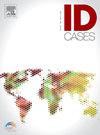Abscesses of the spine and iliac fossa caused by infection with the opportunistic bacterium Fusobacterium nucleatum
IF 1.1
Q4 INFECTIOUS DISEASES
引用次数: 0
Abstract
We present a case of spinal and iliac fossa infection caused by Fusobacterium nucleatum in a 52-year-old male patient with unexplained back pain. Notably, the patient had no history of periodontal infections.Magnetic resonance imaging (MRI) revealed abscesses at the L3-4 vertebrae and hip, with dura mater and cauda equina compression.Next-generation sequencing (NGS) of the aspirate confirmed the presence of Fusobacterium nucleatum. The patient was treated with antibiotics (carbapenems, and metronidazole) and underwent surgical procedures for abscess drainage and internal fixation, resulting in the removal of 1000 ml of pus. Following a 46-day recovery period, the patient made a full recovery.This rare infection poses a significant diagnostic challenge due to its insidious onset and low blood culture sensitivity. The role of next-generation sequencing (NGS) in this context is paramount, as it has been instrumental in arriving at an accurate diagnosis and formulating an effective treatment plan. In view of the challenges posed by this infection, NGS emerges as a crucial tool for the diagnosis and management of unexplained infections.
由机会性核梭杆菌感染引起的脊柱和髂窝脓肿
我们报告一例由核梭杆菌引起的脊柱和髂窝感染,患者为52岁男性,背部疼痛原因不明。值得注意的是,患者没有牙周感染史。磁共振成像(MRI)显示L3-4椎骨和髋关节脓肿,伴硬脑膜和马尾受压。抽吸物的下一代测序(NGS)证实了核梭杆菌的存在。患者接受抗生素(碳青霉烯类和甲硝唑)治疗,并接受外科手术进行脓肿引流和内固定,最终取出1000 ml脓液。经过46天的恢复期,患者完全康复。这种罕见的感染由于其潜伏的发病和低血培养敏感性,对诊断提出了重大挑战。在这种情况下,下一代测序(NGS)的作用是至关重要的,因为它有助于准确诊断和制定有效的治疗计划。鉴于这种感染带来的挑战,NGS成为诊断和管理不明原因感染的关键工具。
本文章由计算机程序翻译,如有差异,请以英文原文为准。
求助全文
约1分钟内获得全文
求助全文

 求助内容:
求助内容: 应助结果提醒方式:
应助结果提醒方式:


